
Chiang Rai
The quieter neighbor of Chiang Mai, Chiang Rai is a land of outstanding natural beauty, where visitors looking to avoid the hordes can visit remote hill tribes, spot exotic wildlife, and check out the golden triangle, the former center of the world’s opium trade. Chiang Rai has been inhabited since the 7th century, but it was not until 1262 that King Meng Rai established it as the first capital of the Lanna Kingdom. The capital was later relocated to Chiang Mai and since that time Chiang Rai has lived in the shadow of its neighboring province, though for tourists this is a good thing.Today, Chiang Rai is a traveler’s paradise, endowed with abundant natural attractions and antiquities.
Attractions range from ruins of ancient settlements and Buddhist shrines to magnificent mountain scenery and hill tribe villages. For those interested in the natural side of Chiang Rai, jungle trekking is a magical experience; explore the mountains of the north along various hiking trails, many of which access the villages of diverse hill tribes groups, many of whom maintain their traditional lifestyles.
 Chiang Rai town, which tends to be a little more ‘laid back’ than its more popular neighbor, now competes with Chiang Mai as a tourist attraction and is fast becoming a popular escape for tourists wanting to leave their troubles behind. Chiang Rai, the former capital of the great Lanna Kingdom, is a fascinating province filled with cultural and natural wonders, including the Golden Triangle where Thailand, Laos, and Burma come together; an area that was once the hub of opium production, a trade that had much influence on cultural practices and lifestyles.
Chiang Rai town, which tends to be a little more ‘laid back’ than its more popular neighbor, now competes with Chiang Mai as a tourist attraction and is fast becoming a popular escape for tourists wanting to leave their troubles behind. Chiang Rai, the former capital of the great Lanna Kingdom, is a fascinating province filled with cultural and natural wonders, including the Golden Triangle where Thailand, Laos, and Burma come together; an area that was once the hub of opium production, a trade that had much influence on cultural practices and lifestyles.
Chiang Rai had stayed off the tourist radar for many years, its people enjoying very leisurely development and mostly traditional, rural lifestyles. Until this day, entire clans live together in bamboo houses and each village has its own individual character. Recently tourism has boomed in Chiang Rai, where visitors have come to explore the pristine natural beauty of the countryside and immerse themselves in the indigenous culture, including those of a variety of different hill tribe communities. Fortunately for tourists, Chiang Rai is also a center for community development projects, helping rural villagers develop their attractions without adversely affecting their natural and cultural assets. Key Tips Get briefed at the Population Development Association’s Hill-tribe Education Center prior to organizing or setting out on a trek to visit hill tribe villages.
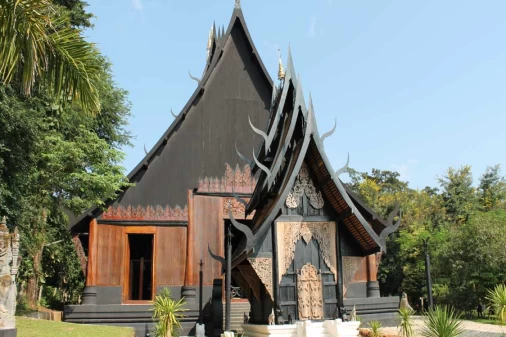
Baandam
Another of Chiang Rai’s more extraordinary sites, in a town that’s blessed with several rather eccentric...
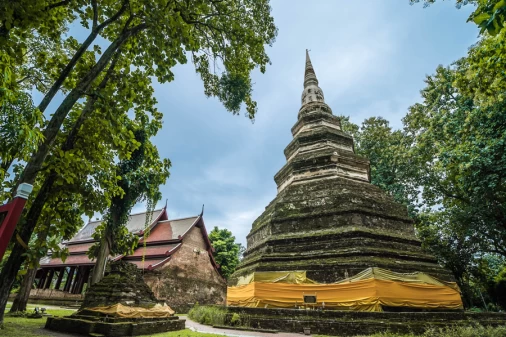
Chiang Saen
Once one of the major cities of the Lanna kingdom, it was originally called Wiang Hiran Nakhon Ngoen...
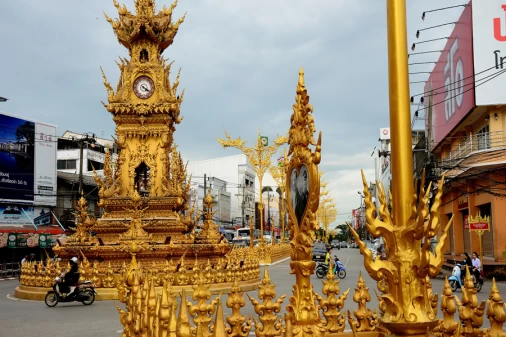
Clock Tower
When you look at all the travel guides and sites about Chiang Rai in Northern Thailand they always use...
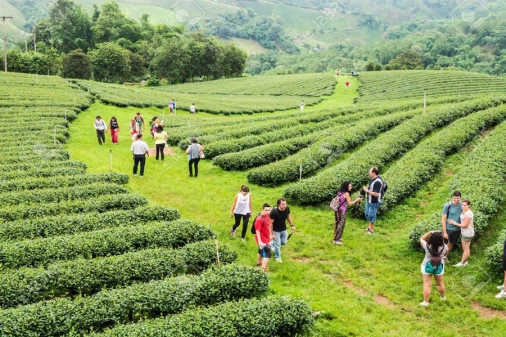
Doi Mae Salong
Mae Salong’s early history centred on the the opium trade of the Golden Triangle. Its recent history...
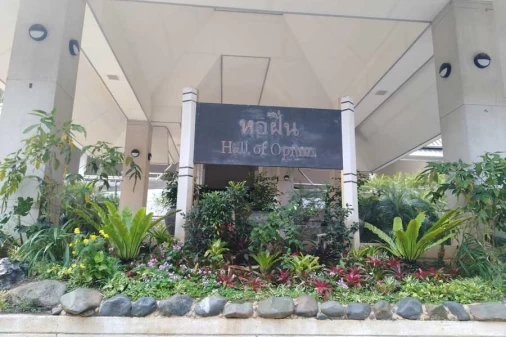
Hall of Opium
The Hall of Opium Museum is a combination of multimedia and exhibition to make learning more fun. Aiming...
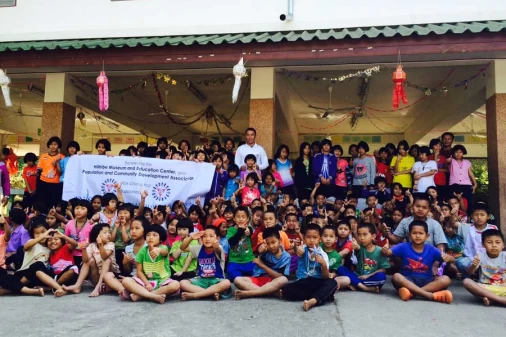
Hill Tribe Museum
Hilltribe Museum and Education Centre is run by a nonprofit organization called the Population and Community...
Frequently asked questions
Chiang Rai is the Northernmost large city in Thailand and was a former capital city of the Lanna Kingdom under the reign of King Mangrai in the 13th century. It is also sometimes referred to as the “Art Capital” of Thailand, and was the birthplace of many Thai artists including Thawan Duchanee and Chalermchai Kositpipat.
The somewhat sleepy mountain town has several notable temples, galleries and attractions to visit, and is a great place to unwind and relax. In comparison to Chiang Mai, Chiang Rai is more laid-back so don’t head over expecting a pumping nightlife scene! Nevertheless, Chiang Rai is worth a quick visit for its unique temples and landmarks showcasing design features that you wouldn’t find elsewhere in Thailand.
1/ White Temple (Wat Rong Khun)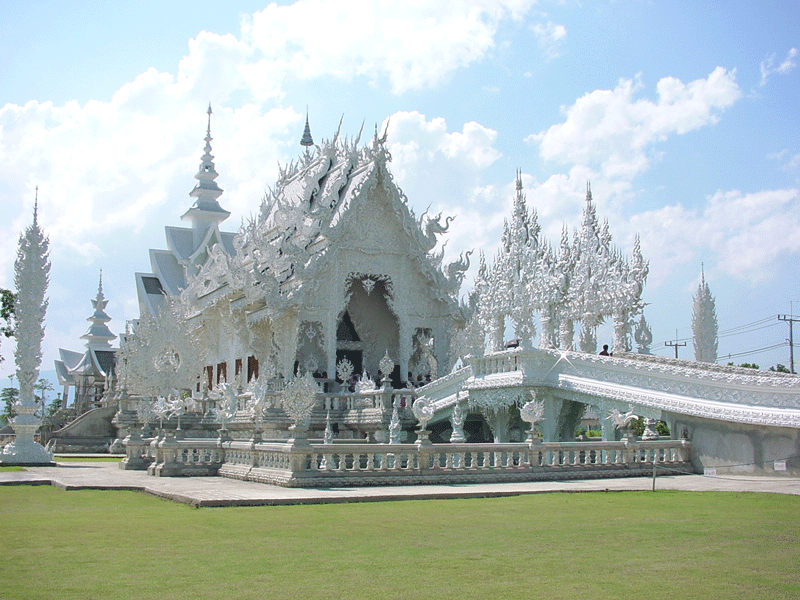 Location: 1 Phahonyothin Rd, Pa O Don Chai, Mueang Chiang Rai, Thailand
Location: 1 Phahonyothin Rd, Pa O Don Chai, Mueang Chiang Rai, Thailand
Open: Daily from 8:00 am to 5:00 pm
Wat Rong Khun is a unique temple that stands out through the white color and the use of pieces of glass in the plaster, sparkling in the sun. The white color signifies the purity of the Buddha, while the glass symbolizes the Buddha’s wisdom and the Dhamma, the Buddhist teachings.
The Wat Rong Khun was designed by Chalermchai Kositpipat, a famous Thai visual artist. To date the temple is not finished. Eventually there will be nine buildings including an ubosot, a hall to enshrine Buddhist relics, a meditation hall, the monks living quarters and an art gallery.
2/ Chiang Rai Clock Tower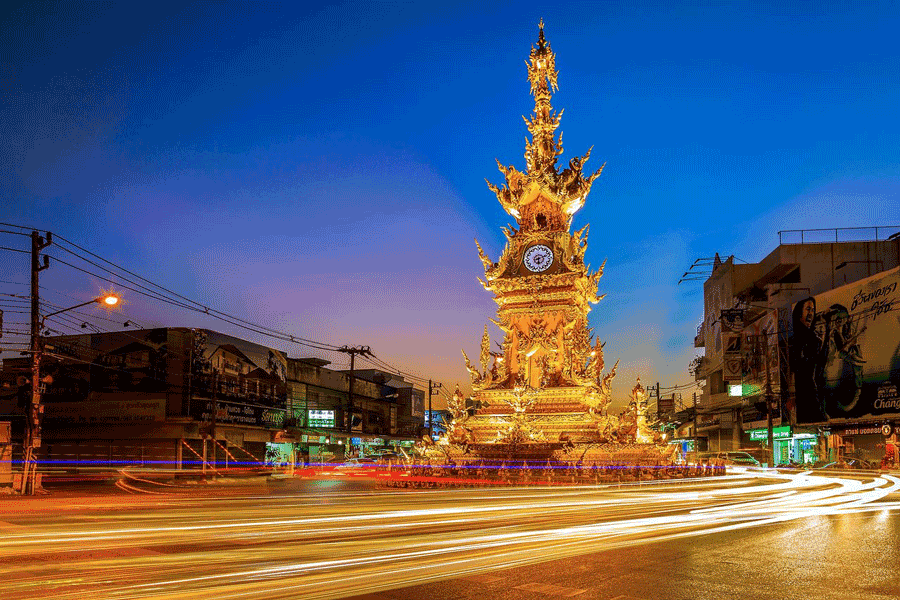 Location: At the junction of Phaholyothin, Jet Yod and Banpaprakan Roads
Location: At the junction of Phaholyothin, Jet Yod and Banpaprakan Roads
If you have already paid a visit to the White Temple, you will not be surprised to see the twisting and swirling spires on the golden clock tower where Phaholyothin Road and Banpaprakan Road meet. Built in 2008 to honour His Majesty King Bhumibhol Adulyadej, the clock tower bears the signature style of Chalermchai Kositpipat, the artist who conceived and built the White Temple. Every evening, at 19:00, 20:00 and 21:00, the clock tower comes to life in a light-and-sound display. While it’s not exactly a must-see, it still draws quite a gathering of visitors and is an interesting addition to the city’s central landmark.
3/ Hill-Tribes Museum and Education Centre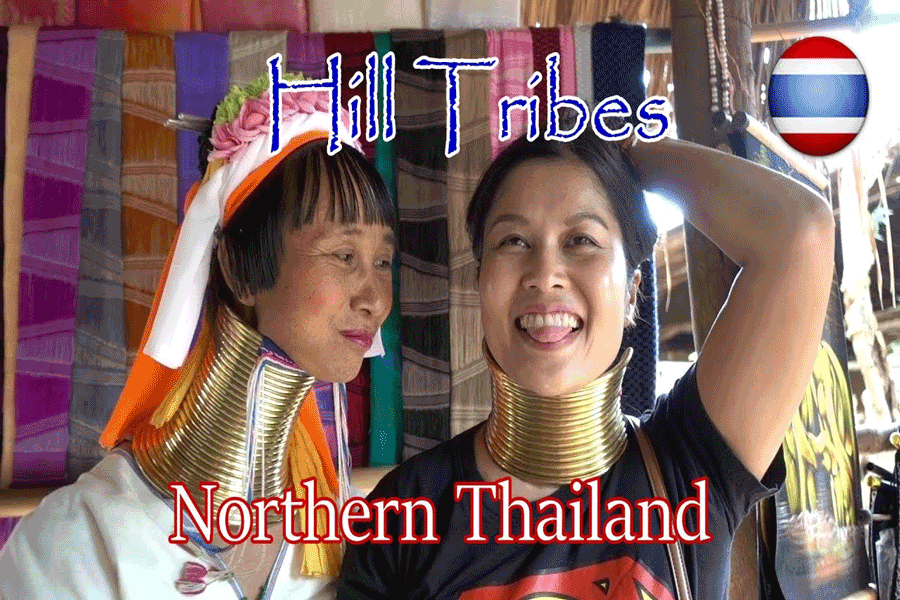 Location: 3rd floor PDA Building, Thanalai Road, Chieng Rai, Thailand
Location: 3rd floor PDA Building, Thanalai Road, Chieng Rai, Thailand
Opening Hours: 09:00 – 18:00 (Mon – Fri); 10:00 – 18:00 (weekends and public holidays)
If you plan to visit the hill-tribe villages, it’s a good idea to first drop by the museum and get familiarized with their culture.
Part of a local NGO group, PDA Chiang Rai, which is the brainchild of former senator Meechai Weera-waithaya and Thailand’s most outspoken advocate for safe sex, the museum aims to build awareness for responsible tourism by educating visitors about Thailand’s ethnic hill-tribe communities and local etiquettes that they should observe when visiting the hill-tribe villages. Housed inside two exhibit rooms, the first showcases the history, customs and traditions of the seven major tribes inhabiting the northern highlands of Thailand, namely Karen, Hmong (Meo), Yao, Lisu, Lahu, Lawa and Akha. You can watch a series of video presentations (available in five languages) to learn more about the hill-tribes, before continuing on to the second exhibit of colourful tribal costumes and bamboo as an essential natural material for the ethic hill-tribes.
4/ The Blue Temple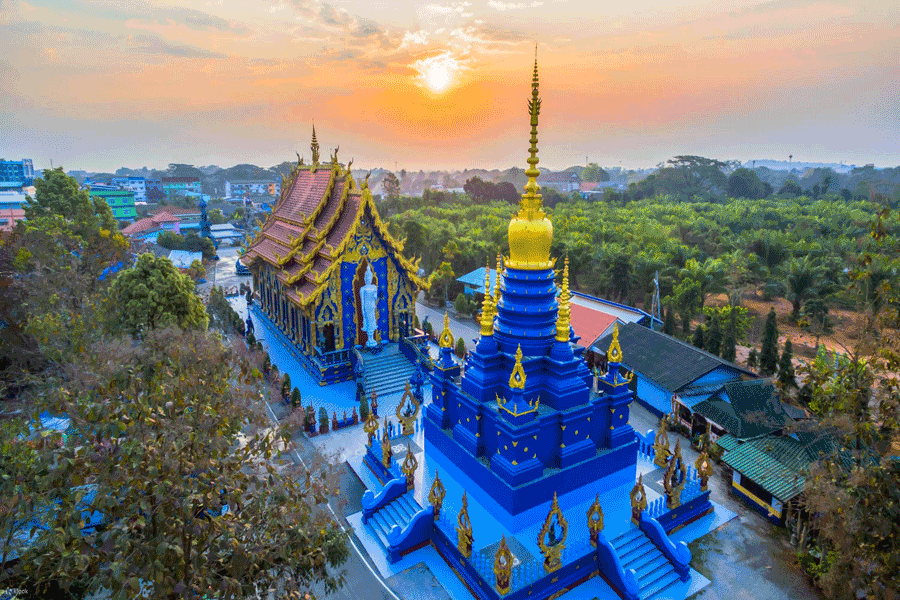 Location: 306 Maekok Rd, Chiang Rai, Thailand
Location: 306 Maekok Rd, Chiang Rai, Thailand
Open: Monday – Sunday: 7:00 am to 8:00 pm
It’s vibrantly coloured, contemporary and kitsch (but in a good way). The inside is also painted in incredible bright patterns and colours. This lesser-known temple is still not widely promoted, so there are less tourists compared to both Wat Rong Khun (White Temple) and the Baan Dam (Black House) Museum.
The monastery was designed by Phuttha Kabkaew, a protégé of Chalermchai Kositpipat, and derives its name from the inhabitants of Rong Suea Ten village. The region was once a natural habitat that teemed with wildlife, including tigers who “danced” (leapt) over the nearby Mae Kok River. The name translates as House of the Dancing Tiger: rong is the Thai word for house, suea for tiger and ten for dancing. In what may prove either to be a disappointment to some or reassurance to others, there are no real, live tigers at Wat Rong Suea Ten.
5/ Mae Fah Luang Art & Cultural Park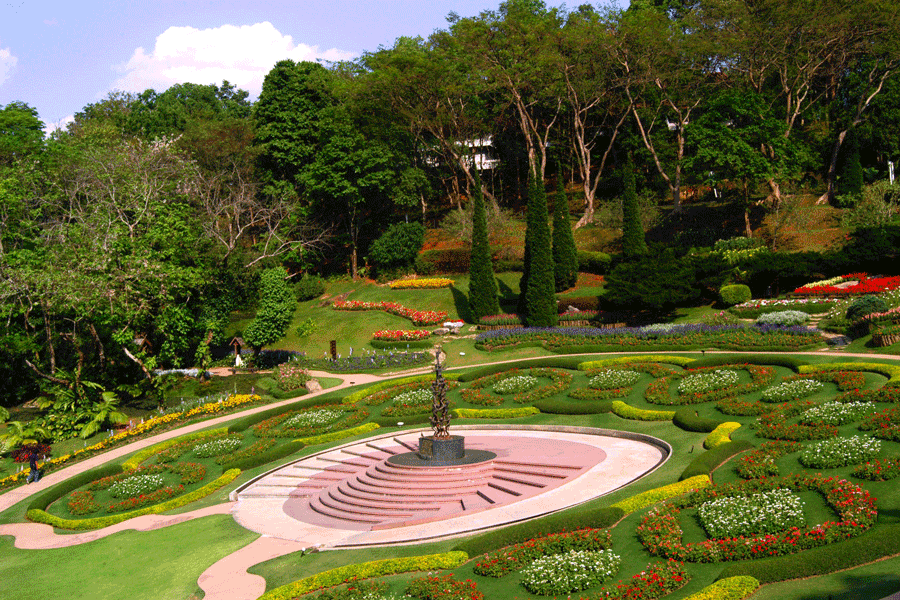 Location: 313 Pa Ngew, Mueang Chiang Rai District, Chiang Rai, Thailand
Location: 313 Pa Ngew, Mueang Chiang Rai District, Chiang Rai, Thailand
Open: From Tuesday to Sunday, 8:00 am – 5:00 pm
If you are short on time but would like to get an over-arching introduction to Chiang Rai’s past and immediate history as well as its cultural heritage, then head over to Mae Fah Luang Art & Cultural Park (about 5km west of the city centre). Set in a lovely landscaped lake garden is a cluster of teak structures, constructed in the styles of traditional Lanna and Tai hill-tribes. Learn about the kingdom’s 400-year history, as you browse the museum’s fascinating collection of secular and religious art and artifacts.
Visit the Haw Kham pavilion and learn about animist and Buddhist rituals, which still co-exist in modern-day Lanna culture. Haw Kaew houses a permanent exhibition of teakwood artifacts. The museum’s admission fee, along with sales at the museum’s crafts shop, is used to support the northern ethnic hill-tribes and their crafts.
6/ The Naval City Pillar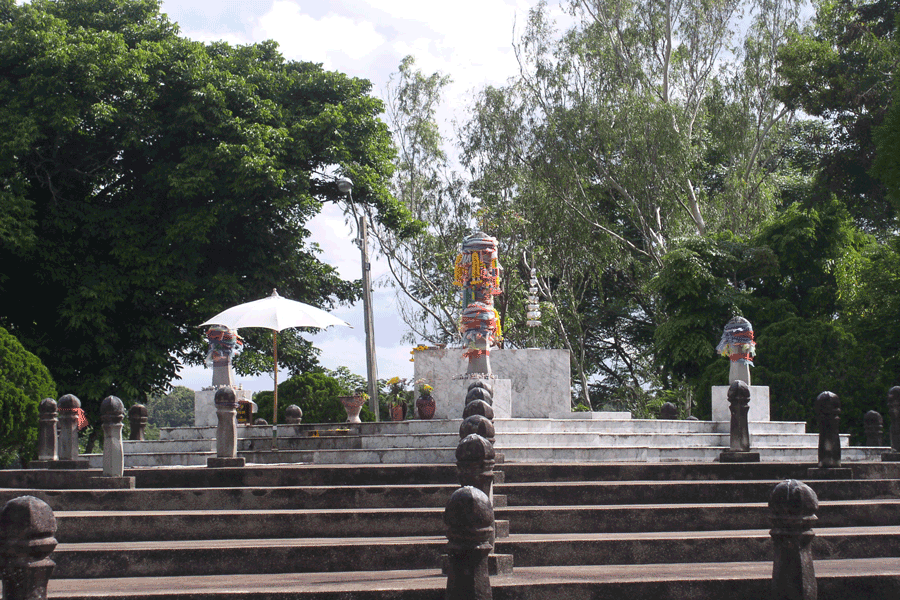 Location: Doi Thong, Arj-Amnuay Road, Chieng Rai, Thailand
Location: Doi Thong, Arj-Amnuay Road, Chieng Rai, Thailand
Fusing ancient Khmer and Lanna concepts of the universe and man’s position in relation to them, the Naval City Pillar is a series of carved stone pillars – about 1m high – set atop Jom Thong Hill. The main pillar – set on a marble pedestal and slightly bigger than the rest – is surrounded by 108 satellite pillars which occupy the six-tiered concentric circles that radiate around it, representing the six lower levels of heaven. Together, the entire site has a supernatural air to it. While up here, catch a glimpse of downtown Chiang Rai, the Kok River, or visit Wat Phra That Doi Chom Thong located in the same vicinity.
7/ Wat Phra Kaew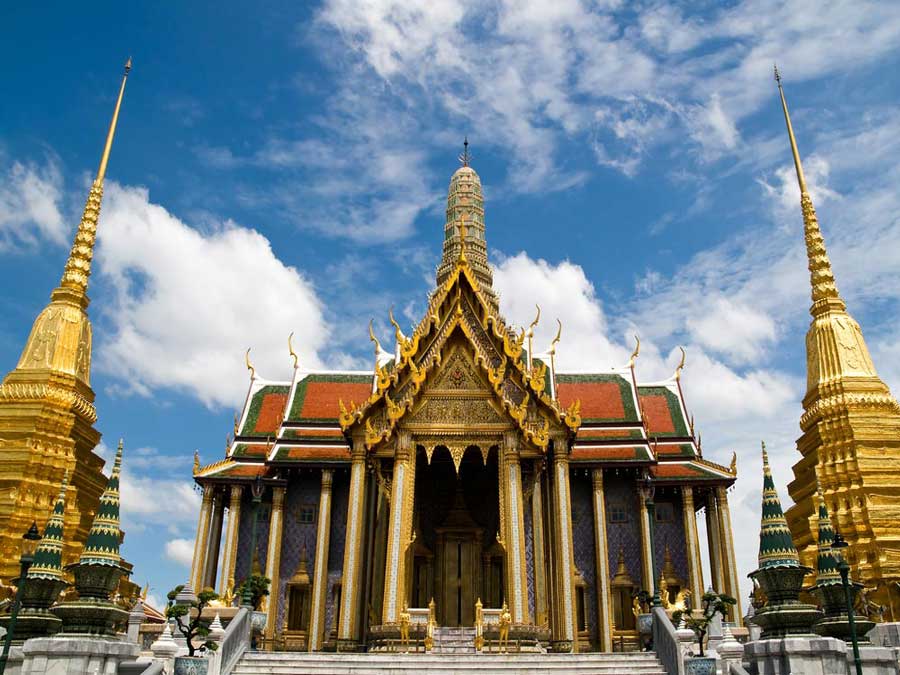 Location: Corner of Trairat and Saeng Kaew Roads, Chieng Rai, Thailand
Location: Corner of Trairat and Saeng Kaew Roads, Chieng Rai, Thailand
Wat Phra Kaew is the original site where the Emerald Buddha (in Bangkok) was enshrined. It was known by the name of Wat Pa Ya (Bamboo Forest Temple), until one stormy night in 1434, a bolt of lightning struck the principal golden stupa, cracking it and revealing the Emerald Buddha inside. The Buddha was then relocated to Lampang, Chiang Mai, Luang Phra Bang, Vientiane and eventually Wat Phra Kaew (Temple of the Emerald Buddha) in Bangkok. Today, a replica of the Emerald Buddha – carved by a Chinese sculptor from a block of Canadian jade – dressed in full regal attire is housed inside the crimson, Lanna-style pavilion behind the chedi.
Guarded by a pair of serpent deities, the main chapel (ubosot) houses the principal Buddha image, Phra Jao Lan Thong, cast from brass and copper in the beautiful Chiang Saen style. Believed to be at least 700 years old, Phra Jao Lan Thong was relocated from the temple of the same name in the old town of Chiang Saen. To the left of the main chapel is an exquisite two-storey pavilion constructed in the ancient Lanna style with gilded roof finials. Inside is a museum with permanent exhibitions on Lanna culture and ancient Buddhist relics.
8/ Doi Mae Salong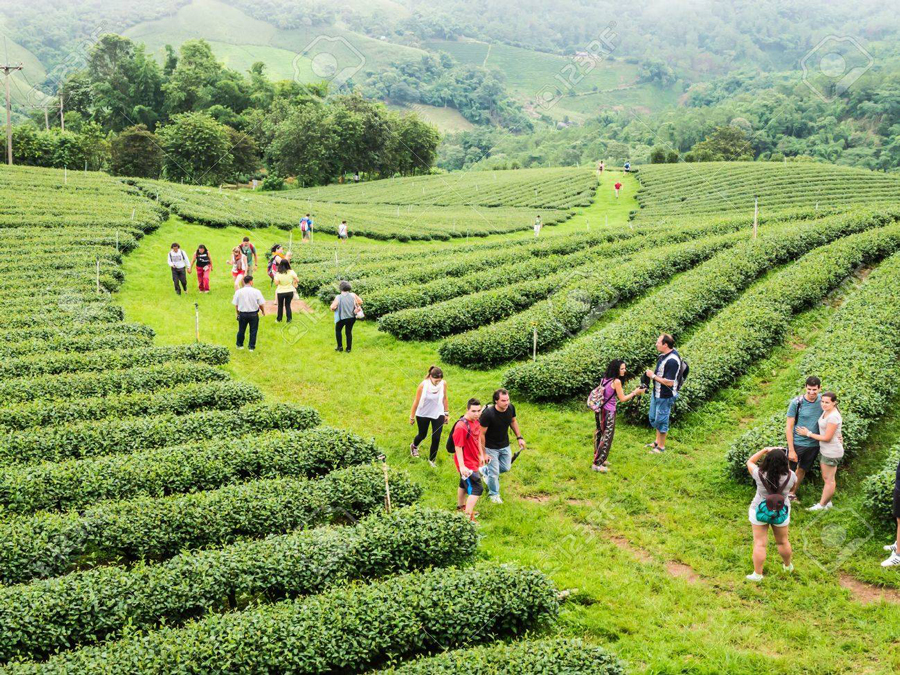 Lying just six kilometers from the border with Myanmar, this lofty peak towers above the countryside surrounding it and the views from the top are stupendous. The nature on offer is fantastic and the best time to visit is between December and February when the hills are alive with blossoms. The surrounding hills are full of coffee plantations and scenic little villages are tucked away here and there. Driving up to Doe Mae Salong is an experience in itself, as picturesque countryside passes you by on either side. Once you arrive, there are lots of lovely little hikes for you to explore.
Lying just six kilometers from the border with Myanmar, this lofty peak towers above the countryside surrounding it and the views from the top are stupendous. The nature on offer is fantastic and the best time to visit is between December and February when the hills are alive with blossoms. The surrounding hills are full of coffee plantations and scenic little villages are tucked away here and there. Driving up to Doe Mae Salong is an experience in itself, as picturesque countryside passes you by on either side. Once you arrive, there are lots of lovely little hikes for you to explore.
Day 1: 4 Color temples – Forest Park
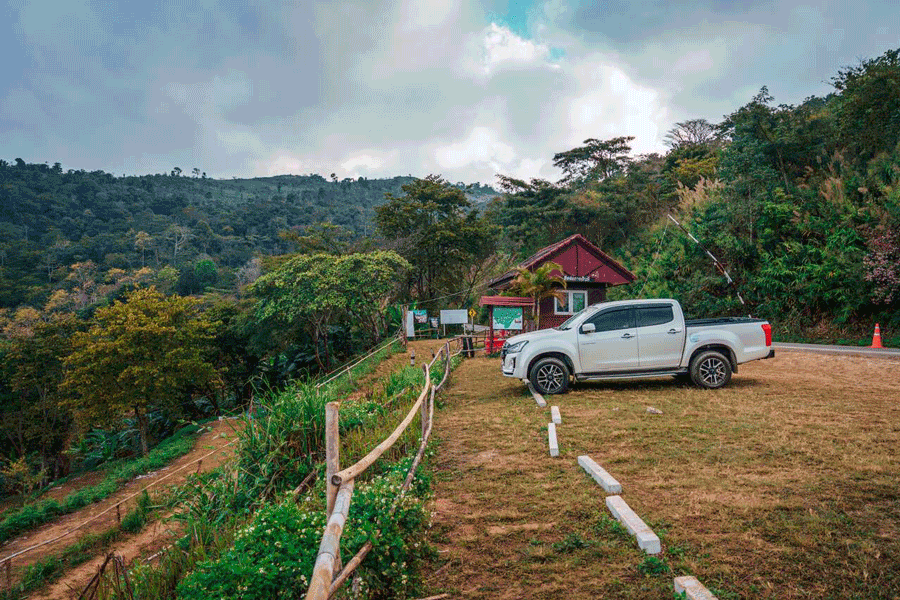 AM: Explore the culture and heritage of Chiang Rai on this day tour. Visit the beautiful Wat Phra Kaew, Wat Phra That Doi Chom Thong, and Wat Rong Khun temples, monuments displaying intricate Thai architecture. Look through the bustling marketplace of Chiang Rai for local handicrafts and produce.
AM: Explore the culture and heritage of Chiang Rai on this day tour. Visit the beautiful Wat Phra Kaew, Wat Phra That Doi Chom Thong, and Wat Rong Khun temples, monuments displaying intricate Thai architecture. Look through the bustling marketplace of Chiang Rai for local handicrafts and produce.
PM: Visit Tham Luang – Khun Nam Nang Non – Forest Park, about 6 km southward from Mai Sai Thai-Myanmar border. This park consists of several different cave systems. But the most famous one is Tham Luang Cave which was brought to international prominence on the 2nd of July 2018, when twelve members of a junior association football team and their assistant coach were found deep inside the cave, trapped due to monsoonal flooding.
Day 2: Doi Mae Salong & Akha Hilltribe Village Full Day Tour Explore the idyllic Santikhiri village in the beautiful mountainside on this day trip from Chiang Rai. Visit the hill tribe villages of indigenous Thai people, learn about their unique way of living, and stop by the local tea and coffee plantations. Enjoy a comfortable pickup from your hotel in an air-conditioned vehicle and begin your journey to Doi Mae Salong Mountain, home to the native Yao and Akha hill tribe villagers.
Explore the idyllic Santikhiri village in the beautiful mountainside on this day trip from Chiang Rai. Visit the hill tribe villages of indigenous Thai people, learn about their unique way of living, and stop by the local tea and coffee plantations. Enjoy a comfortable pickup from your hotel in an air-conditioned vehicle and begin your journey to Doi Mae Salong Mountain, home to the native Yao and Akha hill tribe villagers.
Arrive at the Santikhiri village and greet the friendly villagers, observing their indigenous lifestyle as your good-humored hosts don beautiful embroidered costumes. Head towards the nearby tea and coffee plantations for an insight into cultivating the fresh produce. Walk through the lush greenery and smell the lovely aroma of homegrown tea and coffee.
1/ Khao Soi Gai Nong (Coconut Curry Noodle Soup with Chicken Leg)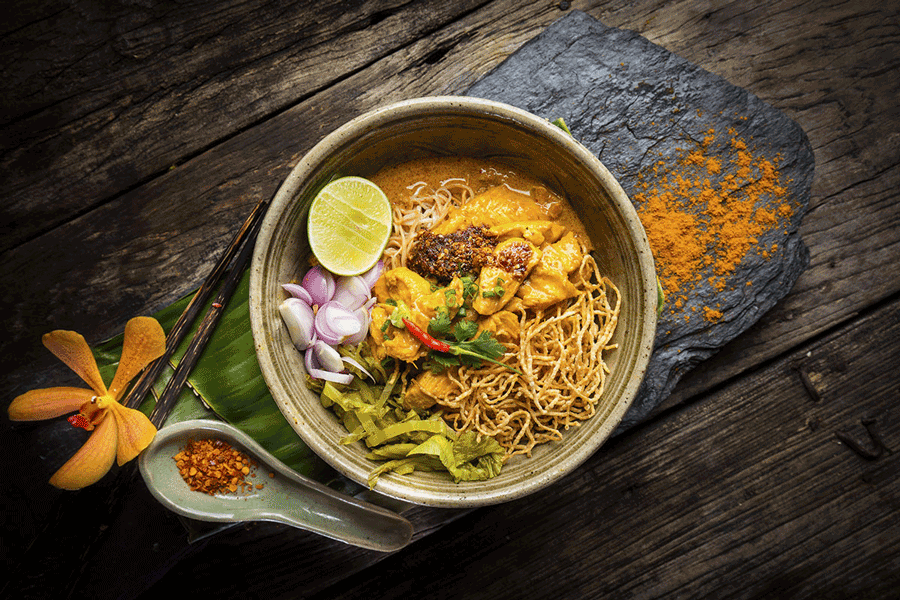 Location: Khun Vijittra’s family, Chieng Rai, Thailand
Location: Khun Vijittra’s family, Chieng Rai, Thailand
You won’t want to miss this northern Thai specialty in Chiang Rai. The spicy coconut curry and tender meat of the chicken leg are just so good. Coupled with crunchy egg noodles and a dusting of coriander, and the addicting combination is complete. Khao Soi also comes with a side serving of red onions, lime, and pickled cabbage.
2/ Sai Ua (Northern Thai Sausage)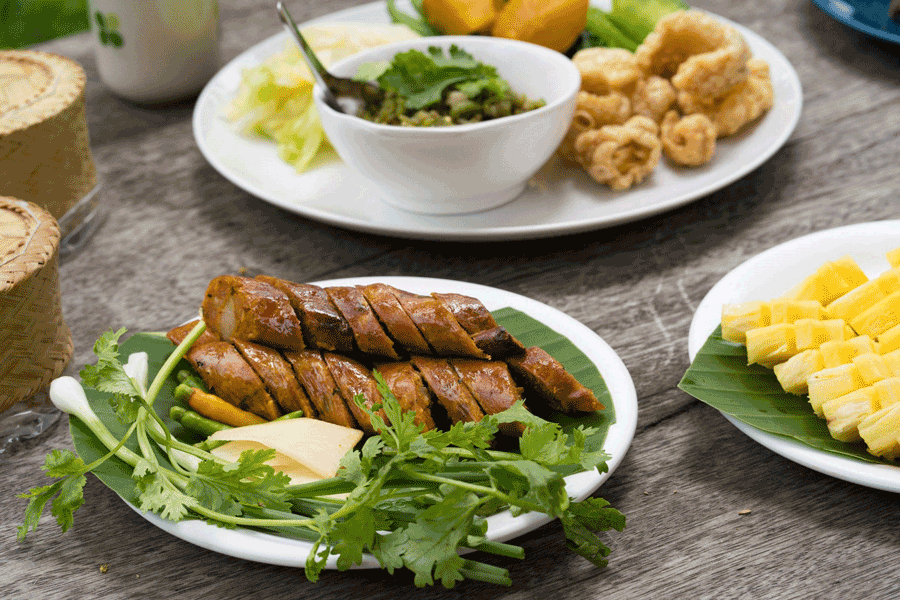 Location: Local shops in Chieng Rai, Thailand
Location: Local shops in Chieng Rai, Thailand
This flavorful grilled sausage is another Chiang Rai food that you simply can’t miss. Minced pork meat is mixed with curry paste, herbs and spices to create an explosion of flavors that will satisfy all your taste buds. The best part is you can find Sai Ua in shops as well if you want to buy them to take back home. Refrigerate them, and they can last for up to a month!
3/ Nam Prik Ong (Tomato and Pork Chili Dip)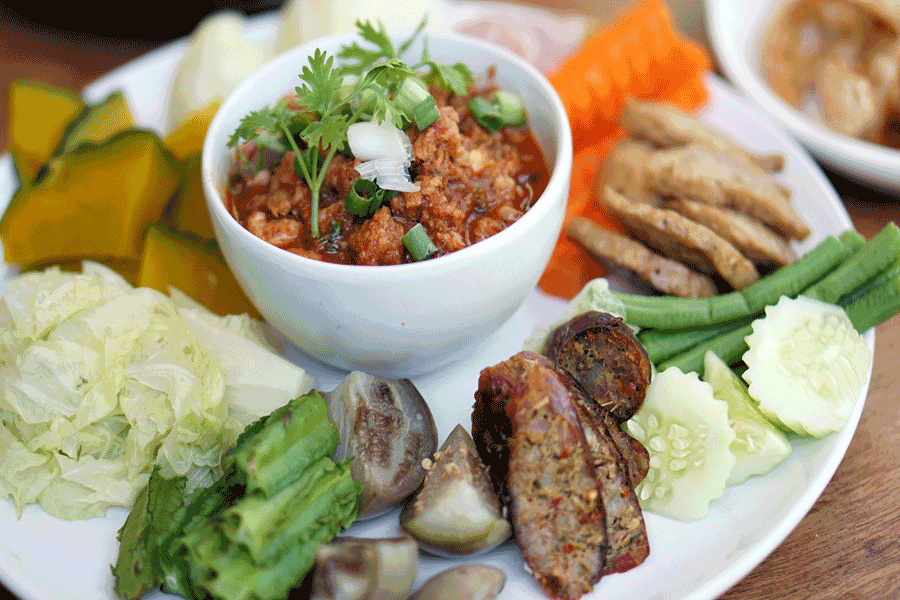 Location: Located between Soi 4 and Soi 5 of Th Sankhongnoi, Chieng Rai, Thailand
Location: Located between Soi 4 and Soi 5 of Th Sankhongnoi, Chieng Rai, Thailand
Don’t let the fiery red look fool you! Usually, Nam Prik Ong is actually not so spicy at all. The chili tomato paste mixed with minced pork is also nicely sweet and a little sour. Eat it with pork crackling, and you probably can’t stop snacking on it! You can also use it as a dipping sauce for Sai Ua, Naem and vegetables.
4/ Gaeng Ho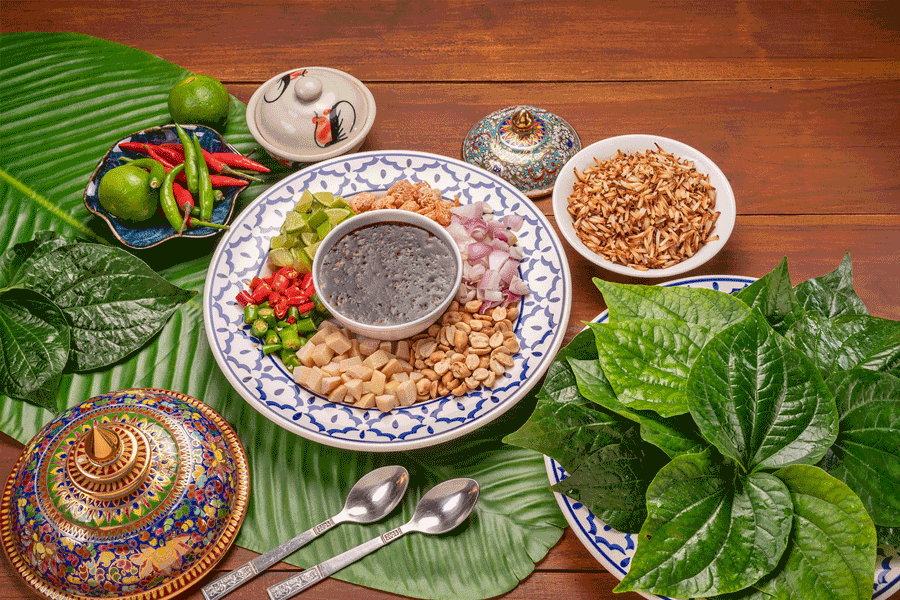 Location: Nong Yao Restaurant, Four Seasons Tented Camp Golden Triangle, Chiang Rai, Thailand
Location: Nong Yao Restaurant, Four Seasons Tented Camp Golden Triangle, Chiang Rai, Thailand
Traditionally an easy, throw-together dish made from leftovers, gaeng ho—also kaeng ho—is a homestyle stir-fry dish that combines pork, bamboo shoots, kaffir lime leaves, lemongrass, chili paste, crispy vegetables and anything else on hand, all served over a mountain of glass noodles. The dish is typically served with a side of homemade chili paste, so you can add the heat to your liking.
5/ Kaeng Khanun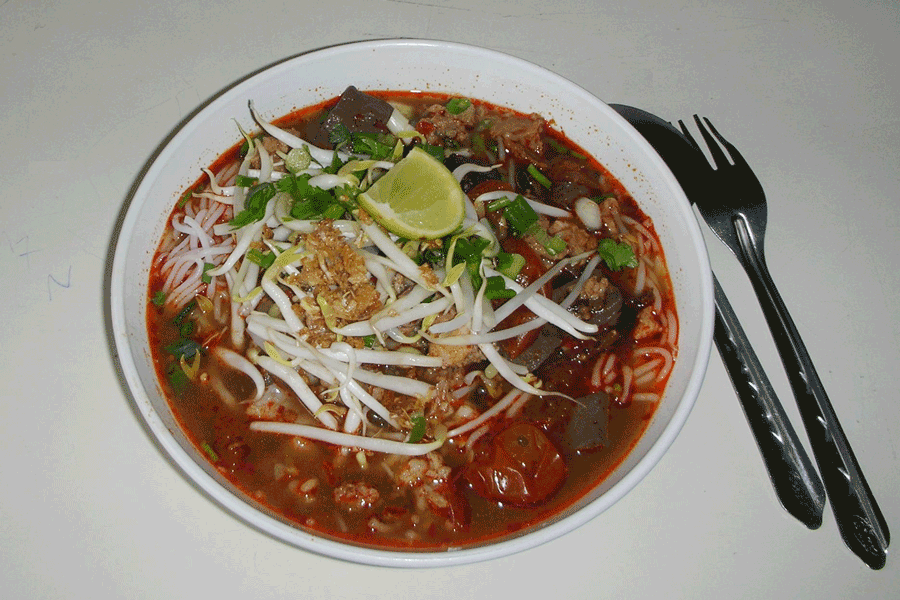 Location: Lu Lam Restaurant, 188/8 Moo 20, Talat Chiang Rai Market, Kwai Wai Road, Chiang Rai, Thailand
Location: Lu Lam Restaurant, 188/8 Moo 20, Talat Chiang Rai Market, Kwai Wai Road, Chiang Rai, Thailand
Also known as jackfruit curry, kaeng khanun soup is usually available in the springtime, starting around March. If the timing works out, jackfruit curry is worth a try. This healthy soup is relatively light, incorporating pork, cherry tomatoes, lemongrass, galangal and, of course, giant chunks of jackfruit. The result is a slightly sour, subtly spicy soup that’s not unlike the more familiar tom yum.
The best time to visit Chiang Rai for outdoor activities is from October to February. This period belongs to the cool season in Thailand (although to many westerners the weather in this period can seem pretty hot). This season provides blue clear skies with cool and refreshing weather.
Nevertheless, Chiang Rai is an all-year-round tourist destination, so visitors may come at any time.
 Chiang Rai has three seasons in a year. If October to February is the cool season, then March to May is the hot season, and June to September is the rainy season. The hottest temperature is 36oC (97°F) and the lowest temperature is 10°C (50°F). The length of the daytime in Chiang Rai may vary over the year. Moreover, we can say that the average sunny day of the dry season (cool and hot season) is about 12-13 hours, but it will be shorter in the rainy season, about 10 hours.
Chiang Rai has three seasons in a year. If October to February is the cool season, then March to May is the hot season, and June to September is the rainy season. The hottest temperature is 36oC (97°F) and the lowest temperature is 10°C (50°F). The length of the daytime in Chiang Rai may vary over the year. Moreover, we can say that the average sunny day of the dry season (cool and hot season) is about 12-13 hours, but it will be shorter in the rainy season, about 10 hours.
Rainfall is usually heaviest in August and September, with the average precipitation of 250 mm (9.8 inches). It is rare to have rain in the cool and the hot season. The annual average rainfall is 173.7 mm (6.8 inches).
By air: Chieng Rai has a domestic terminal with daily flights from major airports including Bangkok, Phuket and Chiang Mai. Popular budget airlines are AirAsia Thailand, Nok Scoot, and Thai Smile.
 By bus: Bus from Bangkok to Chiang Rai is a very popular route. Chiang Rai has many interesting tourist attractions such as Wat Rong Khun, Wat Rong Seur Ten and Wat Huay Pla Kang, these three temples are very popular.
By bus: Bus from Bangkok to Chiang Rai is a very popular route. Chiang Rai has many interesting tourist attractions such as Wat Rong Khun, Wat Rong Seur Ten and Wat Huay Pla Kang, these three temples are very popular.
Throughout this article, we wish you to have an idea of how to travel to Chieng Rai for your best experience. In case you are looking for your own travel agent, who can offer a wonderful and hassle-free trip, please feel free to let us know. We always commit our best to make it your once-in-a-lifetime journey.
You may also like
The Best of Thailand 7 Days
- Depart Time:Daily
- Starts/Ends:Bangkok/Chiang Mai
- Tour type:Private Tours
- Travel Style:Nature & Adventure, Family Tours, Culture & History
- Activities:Sightseeing Tours, Local culture tours, Cultural, religious and historic sites tours, Countryside and village visits tours
- Suitable for:Solo, Family, Group, Couple
- Age range:1 To 90 Years
- Operated in:English, French, Spanish, German, Italian
Amazing Thailand 10 Days
- Depart Time:Daily
- Starts/Ends:Bangkok/Bangkok
- Tour type:Private Tours
- Travel Style:Nature & Adventure, Heritage Tours, Culture & History
- Activities:Sightseeing Tours, Local culture tours, Cultural, religious and historic sites tours, Countryside and village visits tours
- Suitable for:Solo, Family, Group, Couple
- Age range:1 To 90 Years
- Operated in:English, French, Spanish, German, Italian
Best of the North Thailand 11 Days
- Depart Time:Daily
- Starts/Ends:Bangkok/Chiang Mai
- Tour type:Private Tours
- Travel Style:Nature & Adventure, Family Tours, Culture & History
- Activities:Sightseeing Tours, Local culture tours, Cultural, religious and historic sites tours, Countryside and village visits tours
- Suitable for:Solo, Family, Group, Couple
- Age range:1 To 90 Years
- Operated in:English, French, Spanish, German, Italian
Romantic Thailand 13 Days
- Depart Time:Daily
- Starts/Ends:Bangkok/Bangkok
- Tour type:Private Tours
- Travel Style:Nature & Adventure, Family Tours, Culture & History
- Activities:Sightseeing Tours, Local culture tours, Cultural, religious and historic sites tours, Countryside and village visits tours
- Suitable for:Solo, Family, Group, Couple
- Age range:1 To 90 Years
- Operated in:English, French, Spanish, German, Italian
Thailand Family Holidays 14 Days
- Depart Time:Daily
- Starts/Ends:Bangkok/Bangkok
- Tour type:Private Tours
- Travel Style:Nature & Adventure, Family Tours, Culture & History
- Activities:Sightseeing Tours, Local culture tours, Cultural, religious and historic sites tours, City sightseeing tours
- Suitable for:Solo, Family, Group, Couple
- Age range:1 To 90 Years
- Operated in:English, French, Spanish, German, Italian
 France
France  Spain
Spain  German
German  Italian
Italian 






 Vietnam Tours
Vietnam Tours  Cambodia Tours
Cambodia Tours  Myanmar tours
Myanmar tours  Thailand Tours
Thailand Tours  Laos Tours
Laos Tours